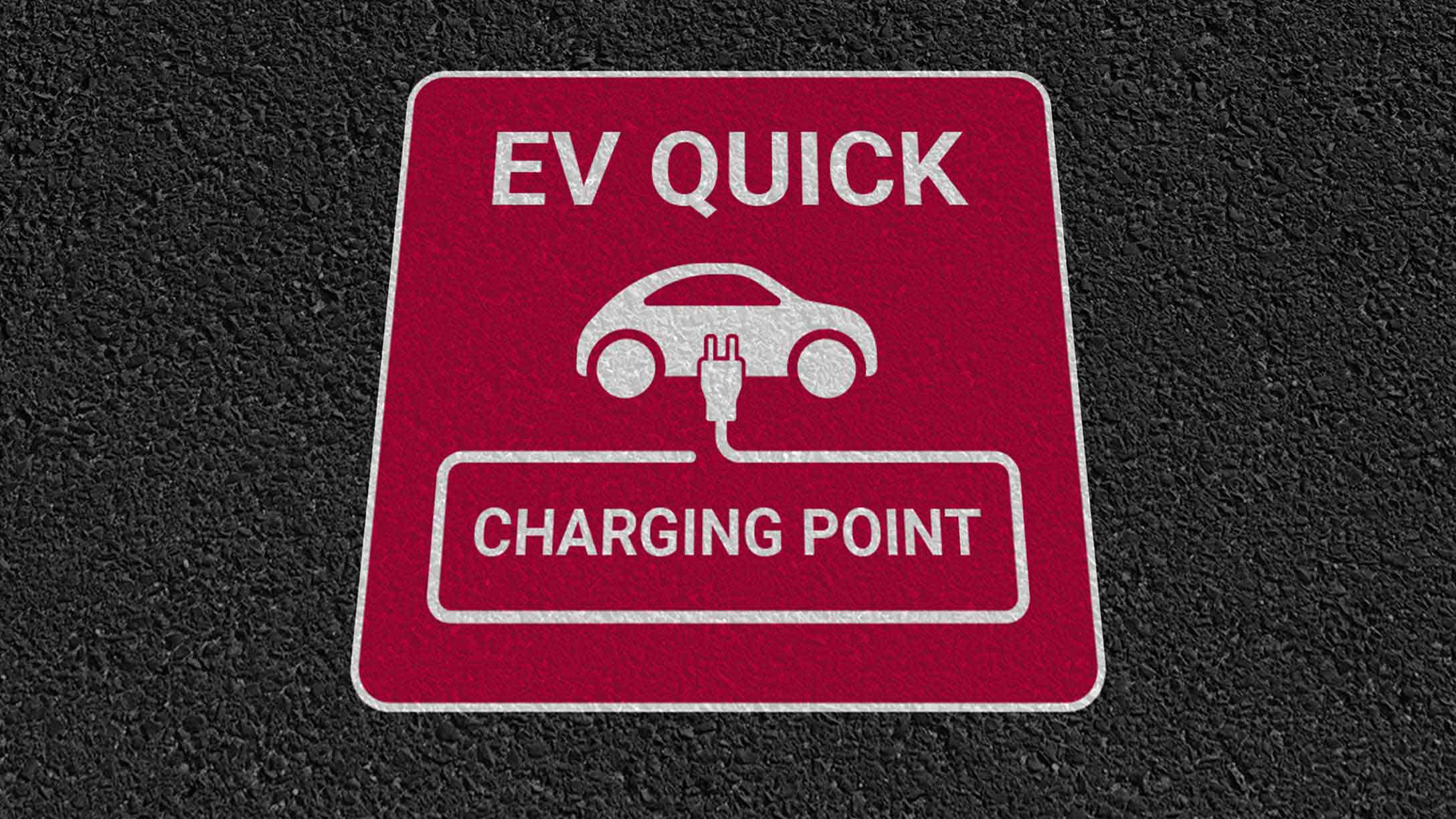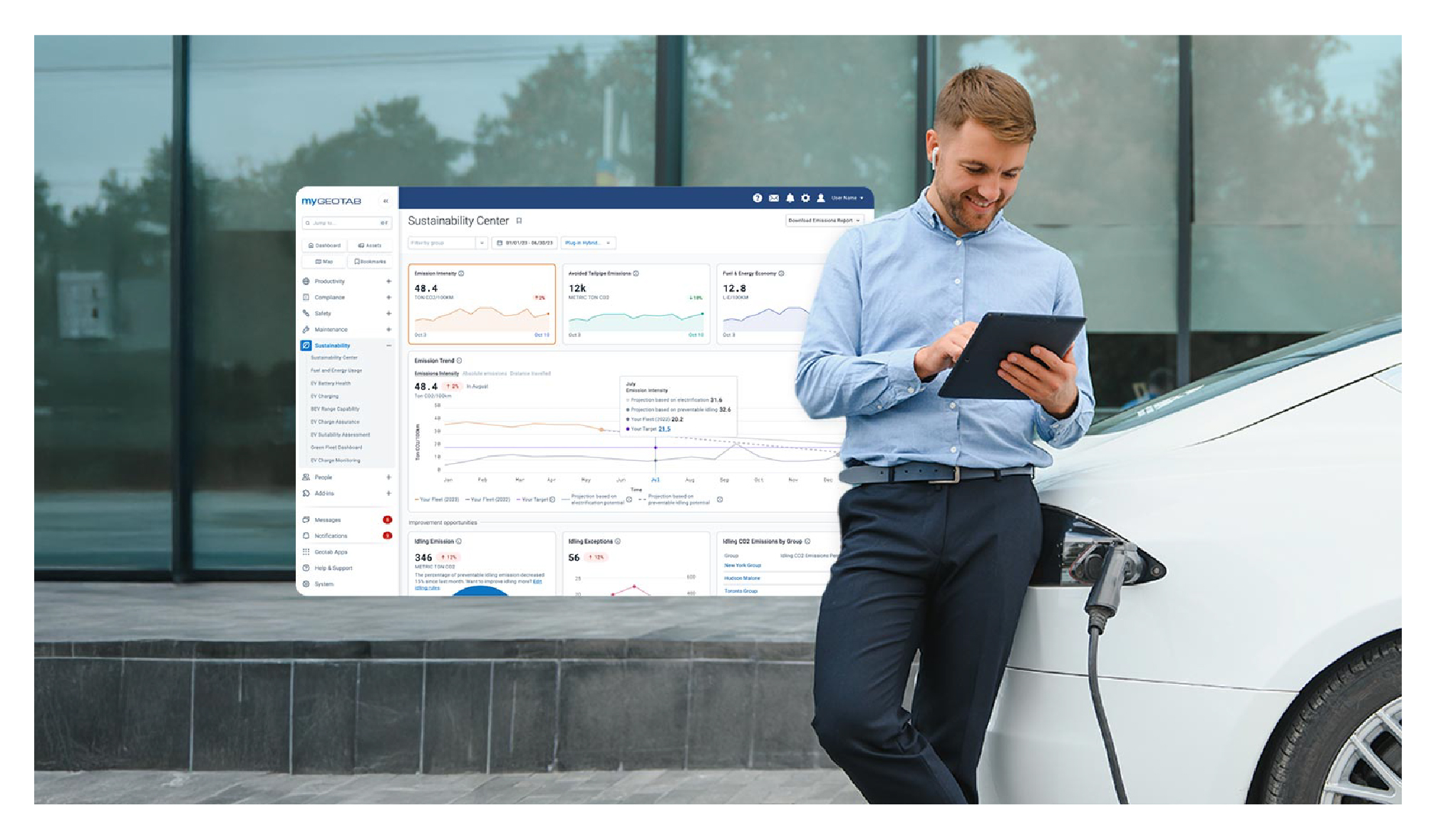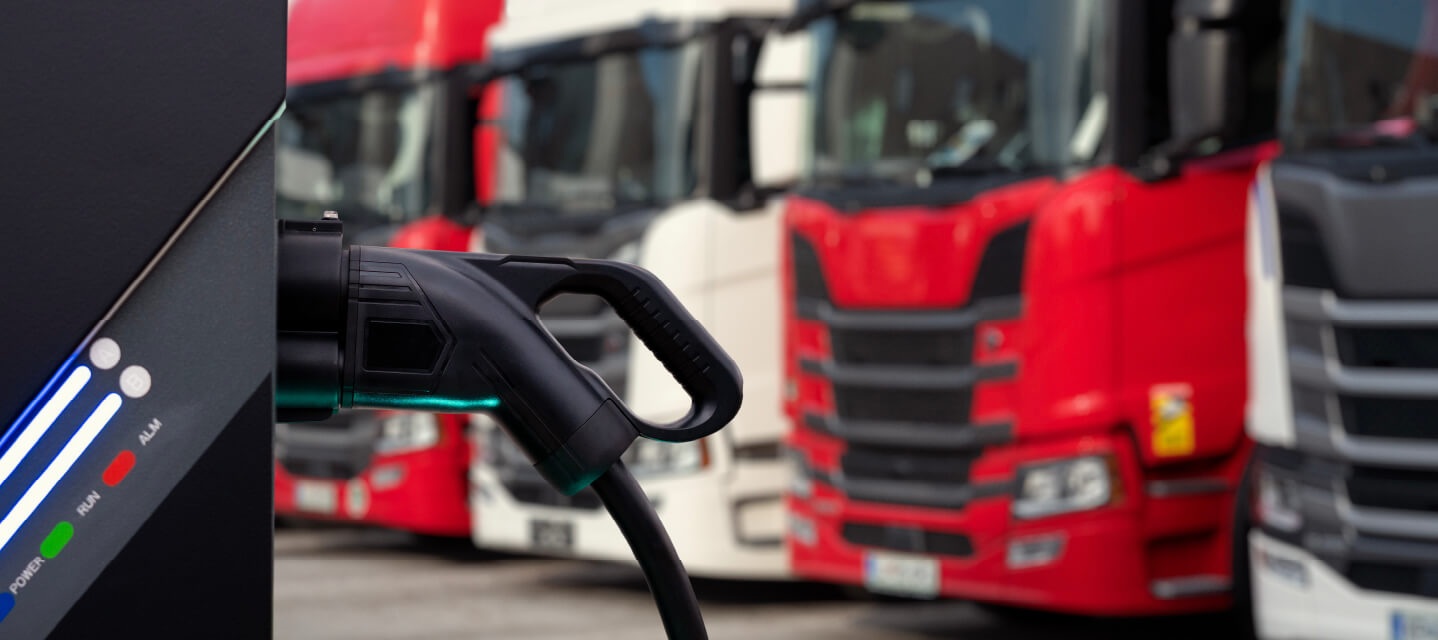What is EV fleet charging?
From charger types to developing a charging infrastructure strategy, here’s what you need to know about EV fleet charging.

Key Insights
- Electric vehicle (EV) fleet charging is the process of recharging EV batteries using charging infrastructure, including level 1, level 2 and direct current fast chargers (DCFC).
- Private (depot), public and home charging are the three most popular charging solutions for EV fleets.
- Becoming an early EV fleet adopter comes with financial incentives and a competitive edge in sustainability.
If you haven’t made the switch to fleet electrification yet, one of your main concerns is probably electric vehicle fleet charging. EV fleet charging is the process of managing the charging of multiple vehicles in a fleet so they can be ready for their next duty cycle. And while it might sound simple enough, implementing a charging program can be rather complex.
Since public charging is typically more expensive and less reliable than privately owned infrastructure, most fleets will opt to build out their own, particularly for return-to-base fleets. However, implementing your own EV charging stations comes with its own set of challenges.
Let’s uncover the most important considerations for EV fleet charging, including the decision between private vs. public infrastructure.
What does EV fleet charging mean?
EV fleet charging refers to the process of recharging electric vehicle batteries using various types of charging infrastructure, including level 1, 2 and DC fast chargers. This process is typically defined in a fleet charging program and overseen by an EV fleet manager. A successful fleet charging strategy clearly defines charging infrastructure, locations and charger types.
Fleet EV charging involves plugging a vehicle into a charging station to "fuel up." This can be done using public charging infrastructure or by installing private charging stations. By carefully planning and implementing a fleet charging strategy, businesses can optimize their EV operations, reduce costs and contribute to a more sustainable future.
Types of EV fleet charging solutions
When it comes to EV fleet charging solutions, there are several options available. Private, public and home charging options each offer distinct advantages and disadvantages, so the right choice for your fleet will depend on several factors.

Private charging
Private charging offers the most convenience and control for fleet vehicles, allowing you to charge at your desired pace and avoid the potential wait times and increased costs associated with public charging. However, this convenience comes at the initial cost of implementing your own charging infrastructure.
To begin, you'll need to determine the appropriate charging level for your fleet's specific needs. Then, you'll need to select an Electric Vehicle Service Equipment (EVSE) Original Equipment Manufacturer (OEM), a company specializing in designing and manufacturing charging station hardware.
| Pros | Cons |
| Electricity costs less than using public chargers | Installing charging stations requires an upfront investment |
| You have full control over charging times | Chargers require ongoing maintenance and support |
| Saves time and reduces range anxiety | You may need to invest in upgrades to accommodate the power demand |
| Minimizes vehicle downtime | Charging stations require space on your property |
| Allows you to track data for energy optimization |
Public charging
Public charging, on the other hand, allows drivers to recharge on the road without having to return to home base. However, it comes with considerations like potential wait times, varying charging speeds and additional electricity costs and fees compared to private charging.
For starters, public charging ports charge more per kWh, which is why it costs more to recharge on the road. This alone is a strong reason to opt for private infrastructure, but there’s also the challenge of longer charging times and coordinating recharging stopping points along routes. That said, public charging can work for smaller fleets, light-duty vehicles and when temporarily adding EVs to your vehicle lineup.
| Pros | Cons |
| Unlike private charging, there's no significant initial investment | Charging speeds can vary significantly between stations |
| Public infrastructure is becoming readily available | It can be difficult to map out when and where to recharge |
| Can recharge without having to drive back to home base | You have limited control over charging times |
| Public chargers cost more per kWh and may involve additional fees |
Home charging
Allowing employees to charge fleet vehicles at home can lead to substantial time and cost savings, giving you the perks of private charging without having to install your own infrastructure. Home charging for fleets is a good option for those who want the cost savings of private charging but don’t have the space or budget to install multiple stations.
Typically, companies will reimburse employees the cost of a home charger (if needed) and the electricity bill — but it can be difficult to track these expenses.
| Pros | Cons |
| Convenient for employees who don’t need to pick up vehicles from depot or office | It can be difficult to track reimbursements |
| Costs less than public charging stations | Doesn’t provide as much data tracking as private infrastructure |
| An alternative solution for small companies without room or budget for chargers | Will require some upfront costs for installation |
| Allows you to fully charge overnight for maximum range |
See also: Electrify your fleet with confidence
Understanding EV charging levels
So just what are the different types of fleet EV chargers and how do they work? There are three main EV charger types you can choose from: level 1, level 2 and DC fast charging. The right charging level for your fleet will largely depend on three factors:
- The vehicle charger port (the connection from the Electric Vehicle Service Provider (EVSP) to your EV)
- Your geographic location and
- The type of EV battery in your vehicles

Level 1 charging
Level 1 charging is the power obtained when plugging the vehicle into a standard household (120V) AC outlet. This is the slowest form of charging, providing roughly 4 miles of range per hour, and is less common for fleet applications due to the longer charging times.
Level 2 charging
Level 2 charging provides power at 200-240V AC through either an EVSE that has a dedicated plug that connects to your car, or via a 240V outlet (similar to the ones your oven or dryer uses) that requires a cable/adapter. Level 2 chargers can provide up to 19kWs and can add 10-65 miles of range in an hour of charging. Because of its faster charge speeds and lower costs compared to DCFC, level 2 charging is a good middle ground for fleets, especially those that have extended periods of dwell time, e.g., overnight.
Direct current fast charging
DCFC is much faster than AC Level 1 or 2 charging and can range from 50kW to 350kW or more. Most fast chargers deliver about 80% charge to a light-duty vehicle in 30 minutes or less. While many fleets prefer fast charging, DCFC chargers come with higher initial implementation costs and potential implications for battery longevity.
How to plan EV fleet infrastructure
One of the biggest challenges for organizations interested in adding EVs to their fleet is planning out the charging infrastructure. It can be an expensive and complex process, so it must be done correctly. But what is EV charging infrastructure and how do you create an effective EV charging strategy?
Here are the four key considerations for a successful charging strategy:
- Charging equipment: Level 1, level 2 and DC fast charging have their own pros and cons. Level 1 and level 2 chargers are less expensive and easier to install. However, it will take longer to charge using them, so they may not be a viable solution for your application. DC fast charging stations can charge your vehicles in a fraction of the time but require significant infrastructure investment.
- Charging location: Determining charging locations will involve looking at the currently available EV charging infrastructure, vehicle dwell time, dwell location, estimated likely state of charge (SOC) and daily driving distances. Depending on your specific applications, you may choose to install chargers at your fleet depot, outside your office buildings or even at your employees’ residences.
- Number of charging stations: Each electric vehicle doesn’t necessarily require its own dedicated charger. However, there’s no one-size-fits-all formula for determining how many charging stations your fleet will need. You will need to consider the duty cycles of the vehicles at each site, how fast you need them charged and the overall energy requirements.
- Energy management: Energy management, or load balancing, allows you to control how much electricity each charging station can use. By setting electricity usage limits, you can ensure better energy efficiency and accurate data tracking across all your fleet vehicles.
Tips to optimize EV fleet charging
Optimizing EV charging can help create a more cost-effective, sustainable fleet electrification program. But just how do you get started and what are the first steps you should take if you’re considering electrification? Here are some tips to kickstart your EV fleet charging strategy.

Be an early EV adopter
With green initiatives and Scope 2 emission mandates on the horizon, early EV adopters can reap competitive and financial benefits. One of the biggest advantages is that there may be local and federal incentives depending on your location. For example, California class 8 vehicles may qualify for a rebate of up to $9,000 per vehicle.
The sooner you transition to electric vehicles, the more incentives you’re more likely to qualify for. But, becoming an early adopter offers more than just financial incentives. With more people prioritizing environmentally friendly choices, adding EVs to your fleet will help position you as a leader in sustainability.
Closely monitor SOC
State of charge measures how full a battery is, making it a crucial part of optimizing your fleet charging process. You can use a telematics system to track the SOC of your EVs in real-time and receive notifications when vehicles reach low charge levels. Monitoring SOC allows you to better manage and coordinate charging schedules to minimize downtime.
Utilize EV charging notifications
In addition to tracking SOC, a telematics system allows you to set charging rules and notifications. For example, you can assign charging zones so drivers get notified when they’re approaching a refueling station.
These notifications improve fleet safety by keeping drivers informed and contribute to energy optimization by ensuring vehicles are charged efficiently and at the most opportune times.
Understand EV charge ranges
Charge range for EVs is a key consideration when transitioning to an electric fleet, especially when trying to combat range anxiety. While ranges can vary, battery advancements have significantly increased the distance electric trucks can travel on a single charge. Most electric vehicles have ranges between 150 and over 400 miles.
See also: Download the EV fleet roadmap
Boost efficiency and lower costs with fleet electrification
Adding EVs to your fleet can seem intimidating, especially when there are so many factors to consider regarding charging. However, the benefits often outweigh the challenges. From fuel savings to reduced carbon emissions, when done effectively, electrifying your fleet can be a worthwhile investment.
If you're unsure about whether adopting an electric fleet is the right decision for your business, our Electric Vehicle Suitability Assessment (EVSA) can help. By analyzing historical data, fleet requirements, geographic location, climate and other factors, the EVSA provides valuable insights into the potential benefits of fleet electrification, including charging needs, which vehicles are suitable for replacement with EVs, estimated total cost of ownership and local availability.
Begin your fleet electrification journey with confidence with an all-in-one telematics solution.
Subscribe to get industry tips and insights
Frequently Asked Questions
Fleet electrification is the process of transitioning from gas- or diesel-powered fleet cars, vans or trucks to electric vehicles. EV fleet management is the process of overseeing electric vehicle operations, from purchasing and maintaining vehicles to installing and managing charging infrastructure.
According to recent trucking industry statistics and a report by Smart Energy Decisions, there are more than one million electric vehicles in commercial and government fleets in the United States, with more than four million projected by 2030.
Installation costs can vary widely based on factors such as charger type and location. Expect installation costs of up to $3,000 for Level 1, $600 to $12,700 for Level 2 and $4,000 to $51,000 for DCFC. Heavy-duty installations may cost significantly more.
How much it costs to charge an EV comes down to the total energy use and the electricity rate. In general, 1 gallon of gasoline is equal to 33.7 kWh of energy. Based on calculations from the U.S. Environmental Protection Agency fuel economy tool, here is the cost to charge a Ford F-150 Lightning pickup truck vs. a similarly powered F-150 with a traditional combustion engine.
| Vehicle | Cost to “fill up” |
| F-150 Lightning 4WD | $1.85 to drive 25 miles
You SAVE $3,500 in fuel costs over 5 years |
| F-150 4WD (gasoline) | $4.23 to drive 25 miles
You SPEND $3,750 more in fuel costs over 5 years |
The Geotab Team write about company news.
Table of Contents
Subscribe to get industry tips and insights
Related posts

What is government fleet management software and how is it used?
April 10, 2025
3 minute read

Enhancing student bus safety: Combating distracted driving in the digital age
April 7, 2025
6 minute read
.jpg)

Geotab’s new fleet Sustainability Center simplifies fuel and emissions reduction
March 3, 2025
3 minute read

How long do electric car batteries last? What analyzing 10,000 EVs tells us…
January 20, 2025
9 minute read
